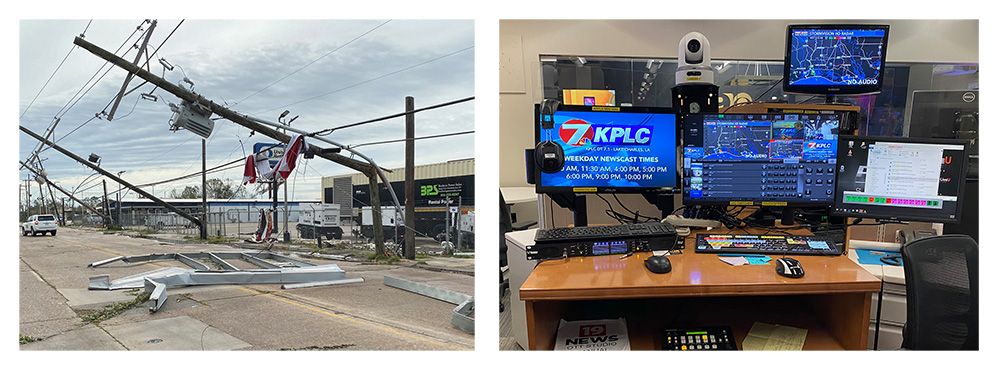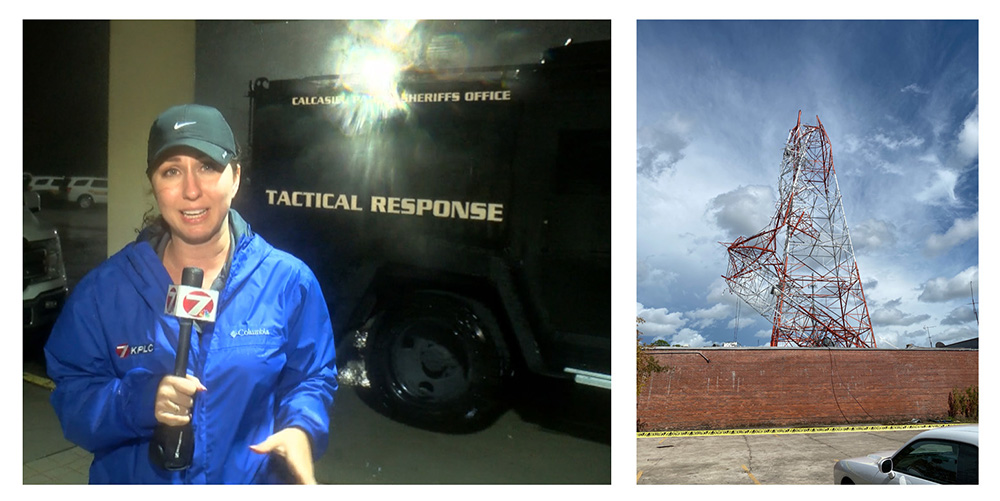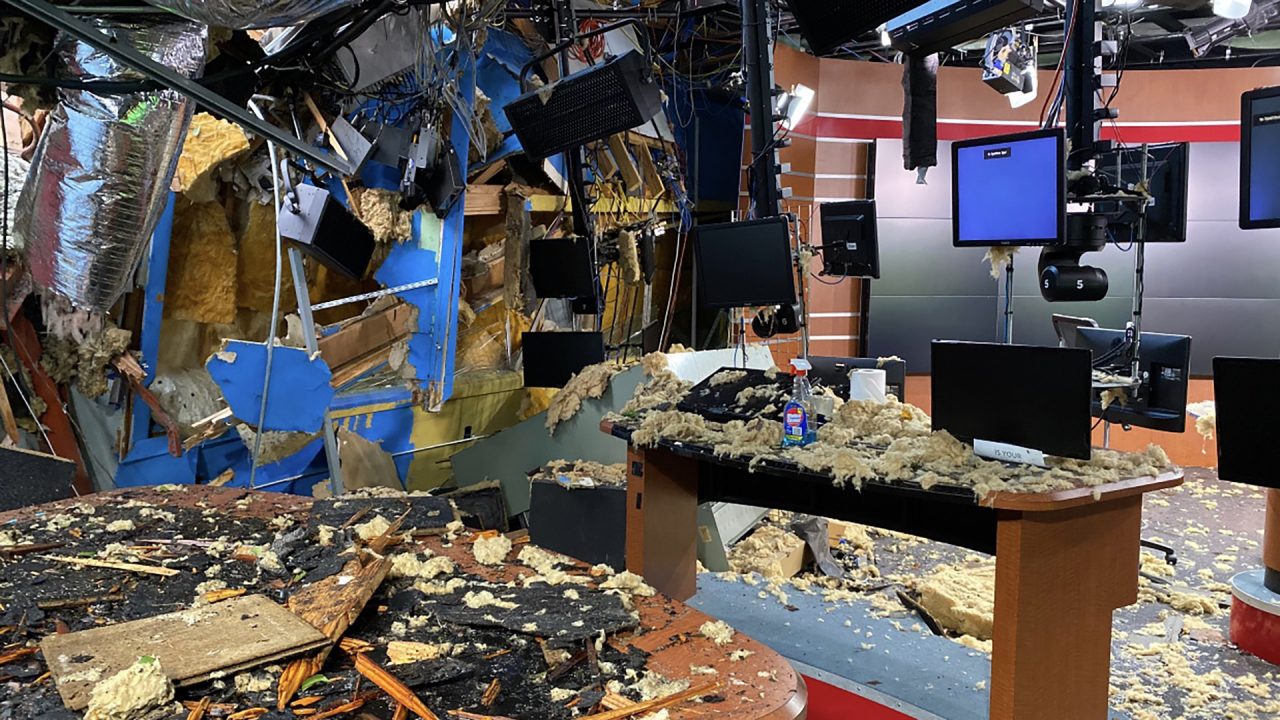As we publish this, Hurricane Delta is bearing down on the Louisiana coast — just six weeks after Hurricane Laura struck the same area with catastrophic impact and tested at least one newsroom’s grit and ingenuity to the limit.
When Laura was approaching southwest Louisiana in August, KPLC General Manager John Ware told his staff they were going to stay put and cover the storm. After all, that’s what the Gray station in Lake Charles had always done to serve its market, where viewers live just off the Gulf of Mexico and deal with lots of extreme weather. “I said, ‘We are going to stay here. We are going to fulfill our mission. We are going to tell the community what they have to do to stay safe,’” says Ware.
Fast-forward a few days: The hurricane was gaining power, forecasters were predicting a deadly storm surge, and it was all heading straight for Lake Charles. So, KPLC broke with tradition. “I don’t want to take credit for the decision to evacuate,” says Ware. “That was Greg. I was like, ‘No, we’re staying,’ and he convinced me otherwise. He showed me a way that it could happen — and it could be better.”
Greg DeBrosse is the station’s news director. Before the hurricane made landfall as a destructive Category Four storm — one of the strongest ever to hit Louisiana — he and his team developed a new coverage plan that helped them stay safe without sacrificing their critical service to the community. Just as the COVID-19 pandemic has sparked creative changes in newsrooms around the country, a weather emergency spurred innovation at KPLC.
The first step was finding a new home base for broadcast. “Gray owns so many stations that we could go to other places,” says DeBrosse, who ultimately coordinated a move to WAFB, about 130 miles away. “It was a little chaotic getting out and getting everybody over to Baton Rouge to continue broadcasting. But it was well worth it, because it kept people from being hurt.”

From Baton Rouge, KPLC provided wall-to-wall hurricane coverage, sending the signal back to Lake Charles using WAFB’s OTT Desk. DeBrosse calls it a “pretty neat piece of technology” that Gray recently invested in for each of its stations: “It’s like a mini studio that can be operated by one person. We could do FaceTime interviews, we could route any of our live shots to it, we could play video directly out of it. That’s how I got a lot on TV for our viewers — load it, tap it, and it would play.”
“The OTT Desk was never meant for it, but they figured out how to build graphics and lower thirds on the screen,” says Ware. “We were able to show what the radar’s doing, and our meteorologist could actually do a far better job by being remote. [In Lake Charles,] you’re going to lose power, you’re going to lose internet, your radar might go out. But by relocating, we were able to do a better job of broadcasting to our home market.”

A few veteran reporters did stay in Lake Charles to gather on-site stories, feeding them to the team in Baton Rouge from safe places. That was another key part of the plan, says Assistant News Director Jillian Corder, who embedded at the sheriff’s office and gave live reports until the storm doors closed. “Our coverage was very, very complete,” she says. “We had reporters in Baton Rouge on the phone with every type of city official and parish leader, and then we had that on-the-ground aspect. I continued to do interviews with the sheriff throughout the night, until about 2 in the morning.”
Corder was also well-positioned to reach KPLC audiences on social media, especially people who had evacuated and were clamoring for information as soon as the hurricane let up. “They raised those storm doors at the sheriff’s office, let us outside, and we immediately had cameras going,” she says. “I was on Facebook Live, and we had a ton of viewers who were tuning in and commenting, ‘Please, can you go to this neighborhood? Can you see what my property looks like?’ Unfortunately, that was not an option, but I think they still got a really good idea of the damage that was done in just a few hours.”
Watch one of Jillian Corder’s reports on damage caused by Hurricane Laura
“TV has this love-hate relationship with Facebook, but it became a critical lifeline for our viewers,” says DeBrosse. “Typically, stations don’t want to do it, because it’s giving away free content and you want them to come to your site. But [Facebook] was the only way some people were getting information. I think our streams had close to a million views.”

Ware calls the online engagement “incredible.” Beyond the Facebook numbers, “we had over a million [website] page views, for a community that has 94,000 television consoles, and 270,000 video views,” he says. “It was just every possible metric we could measure.”
He credits the strong response to KPLC’s consistent delivery of information across different platforms — and the staff’s personal stories that were sometimes peppered in. He says viewers wanted to know about the decision to evacuate, the damage to the station, and the well-being of meteorologist Ben Terry and his cat.
“Somebody made a prayer candle with his face on it and ‘Saint Terry,’” says Ware. “They were selling them to try and raise money because he lost his house, but everyone was so excited when his cat was saved. Those stories really personalized our experience as part of the same community that we’re serving.”
Back at the station, the dreaded storm surge didn’t materialize, but screaming winds did. “Our tower folded over and crashed into our studio,” says Ware. “It came down with enough force to crack the concrete slab and bend a metal roof truss in half. We would have been broadcasting from that studio, so we’re very fortunate that we weren’t in there.”
It was about four weeks before the staff could move back to the station — with the anchor desk relocated to the newsroom. Going forward, Ware says KPLC will look to its coverage of Hurricane Laura as an example during future storms. “That process of being able to go to another county and serve your community from there — I think it’s a model for us,” he says. “You have to be ready to change plans. If we had been stubborn and stuck to our plan, we might have had loss of life of our own employees, and we certainly would not have served the community as well.”
